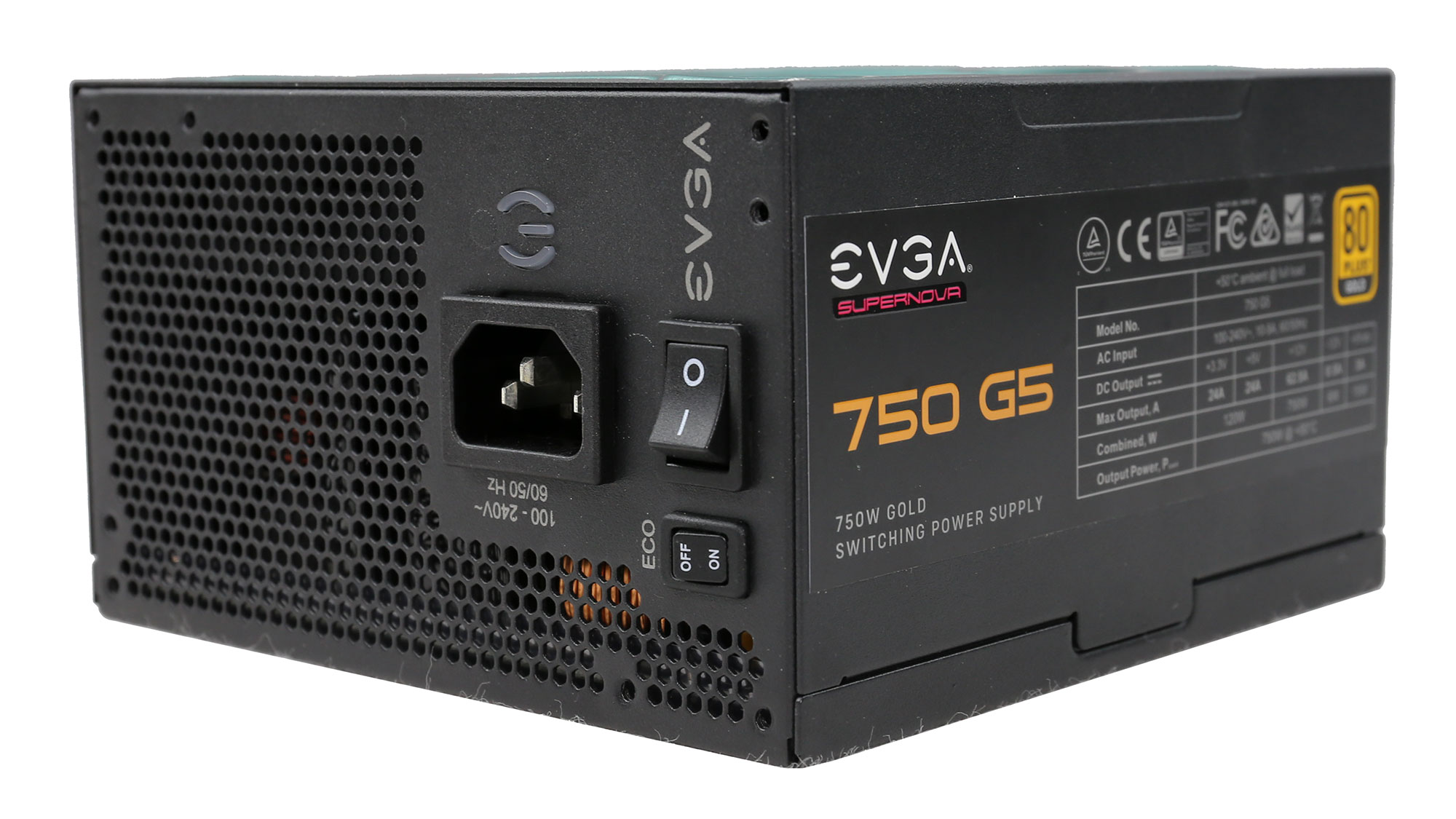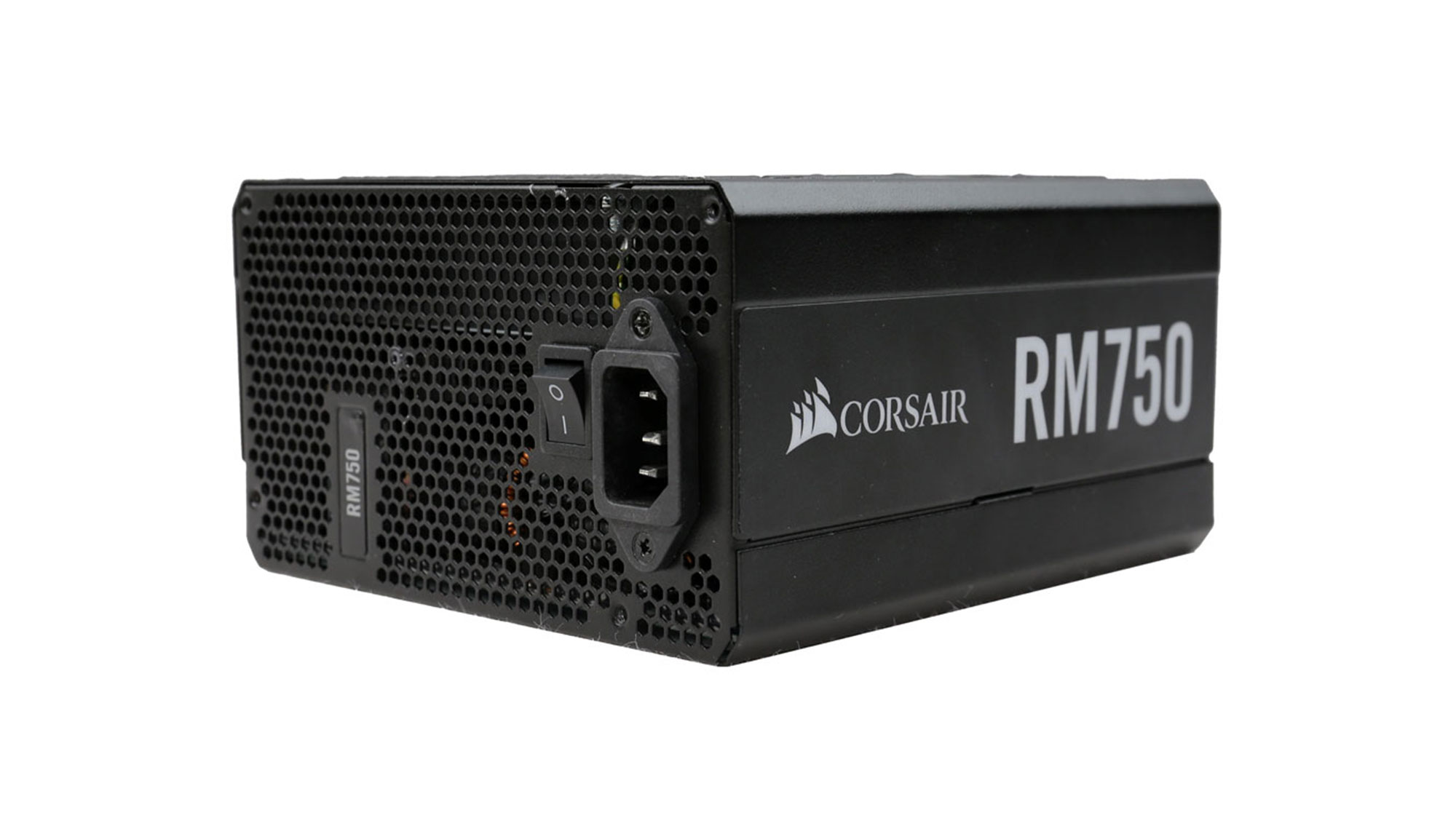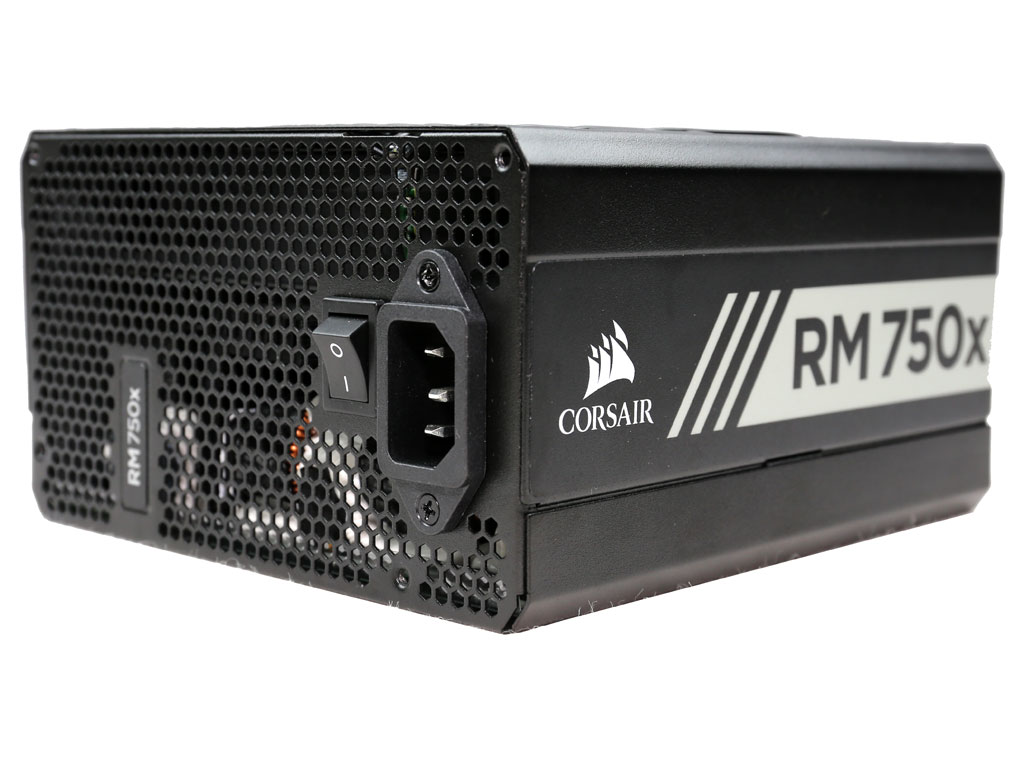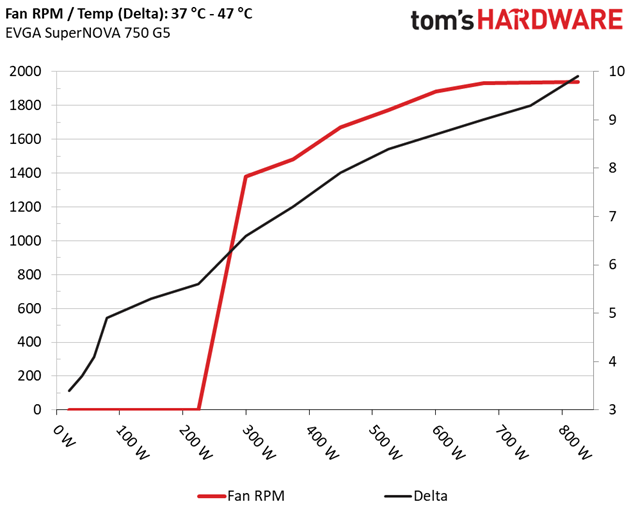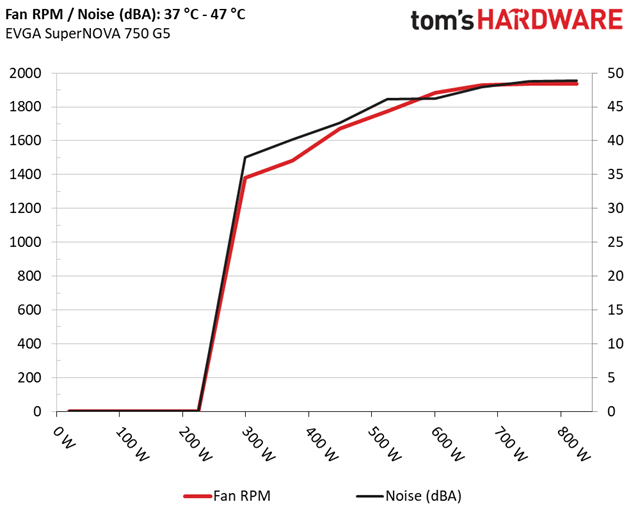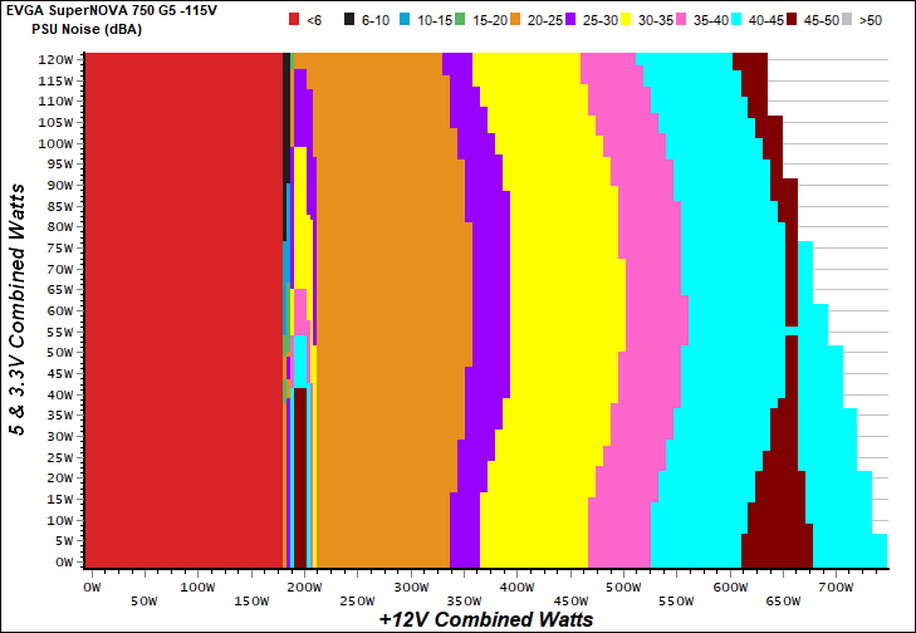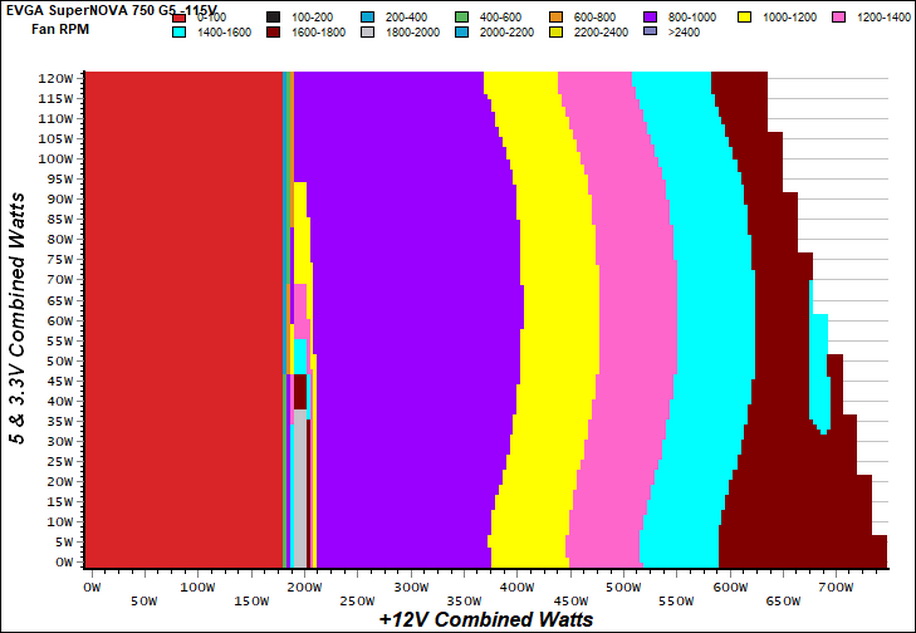EVGA SuperNOVA 750 G5 Power Supply Review
The SuperNOVA 750 G5 is fully modular, compact, and promises for high performance. Will it be able to meet the popular Corsair and Seasonic offerings though?
Why you can trust Tom's Hardware
Load Regulation, Hold-Up Time, Inrush Current, Efficiency and Noise
To learn more about our PSU tests and methodology, please check out How We Test Power Supply Units.
Primary Rails And 5VSB Load Regulation
The following charts show the main rails' voltage values recorded between a range of 40W up to the PSU's maximum specified load, along with the deviation (in percent). Tight regulation is an important consideration every time we review a power supply because it facilitates constant voltage levels despite varying loads. Tight load regulation also, among other factors, improves the system’s stability, especially under overclocked conditions and, at the same time, it applies less stress to the DC-DC converters that many system components utilize.
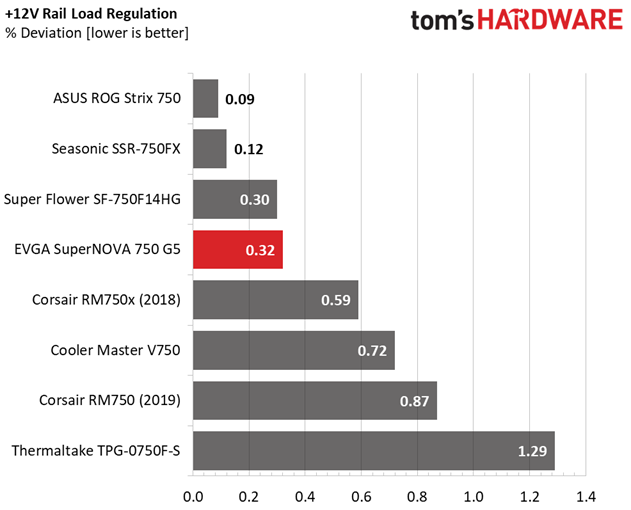
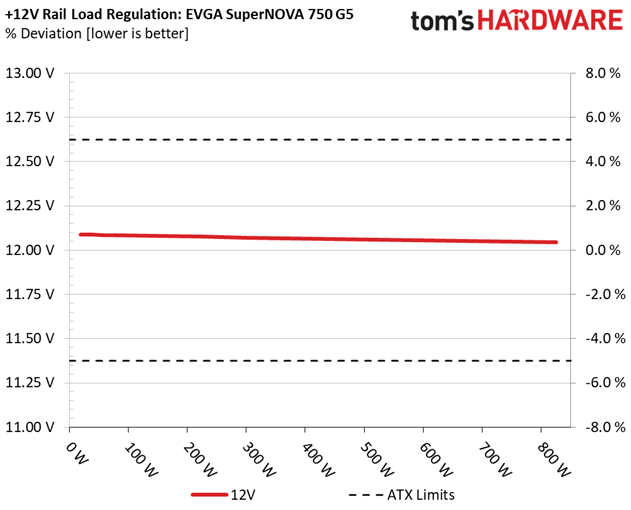
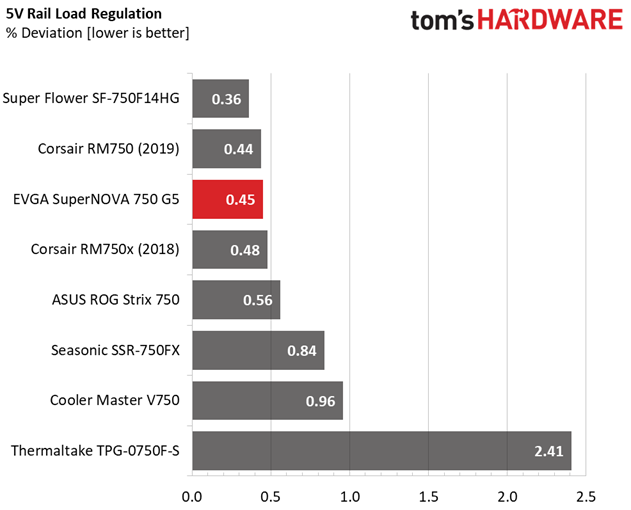
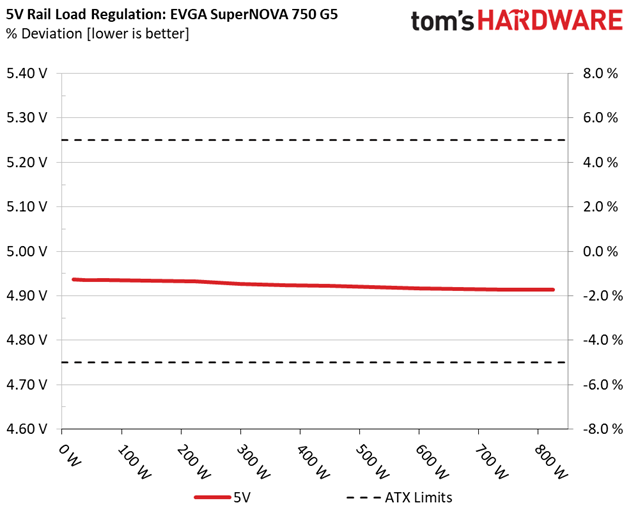
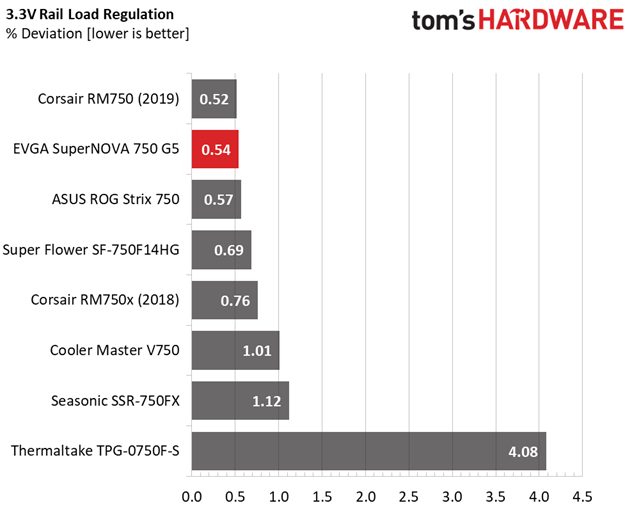
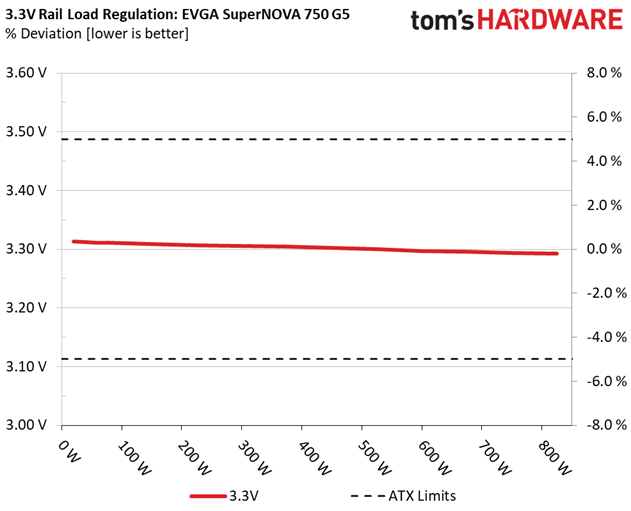
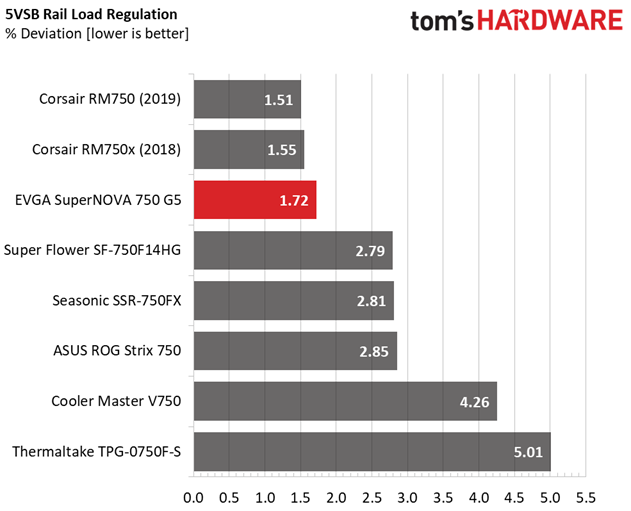
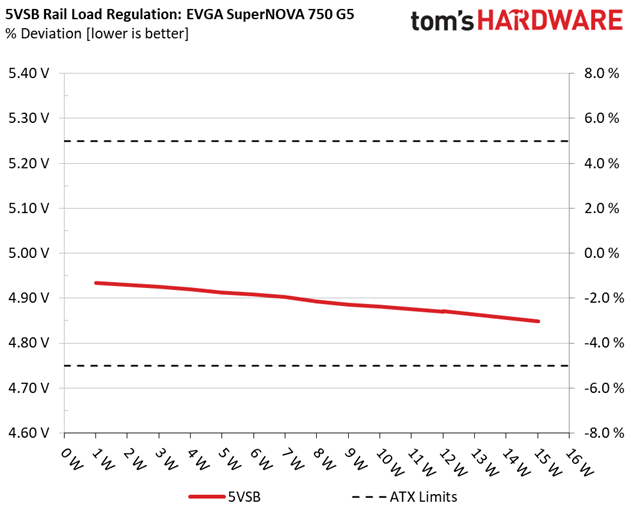
The load regulation is tight on all rails. Unfortunately, we don't have data for the 750 G3 to make comparisons.
Hold-Up Time
Put simply; hold-up time is the amount of time that the system can continue to run without shutting down or rebooting during a power interruption.
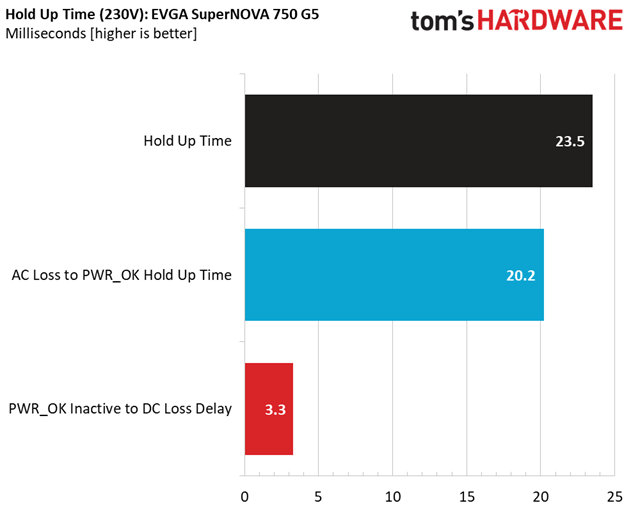
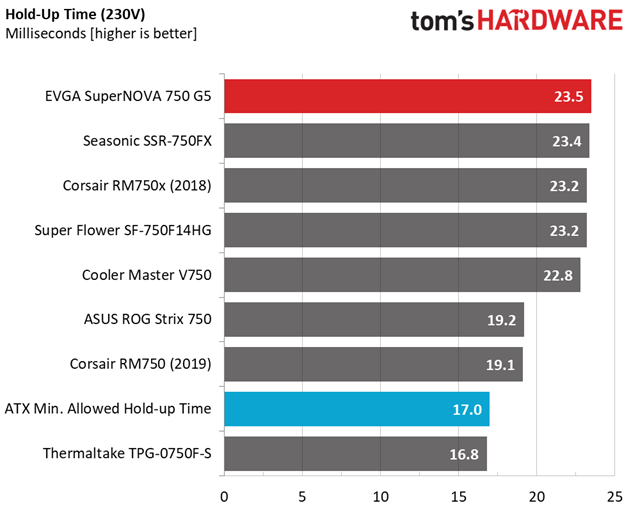
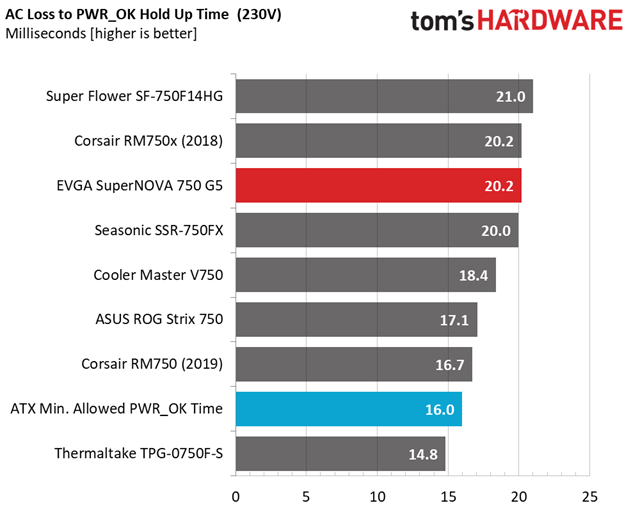
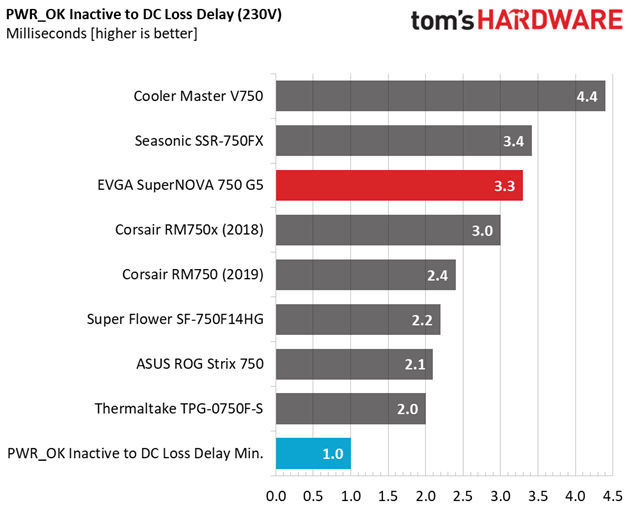
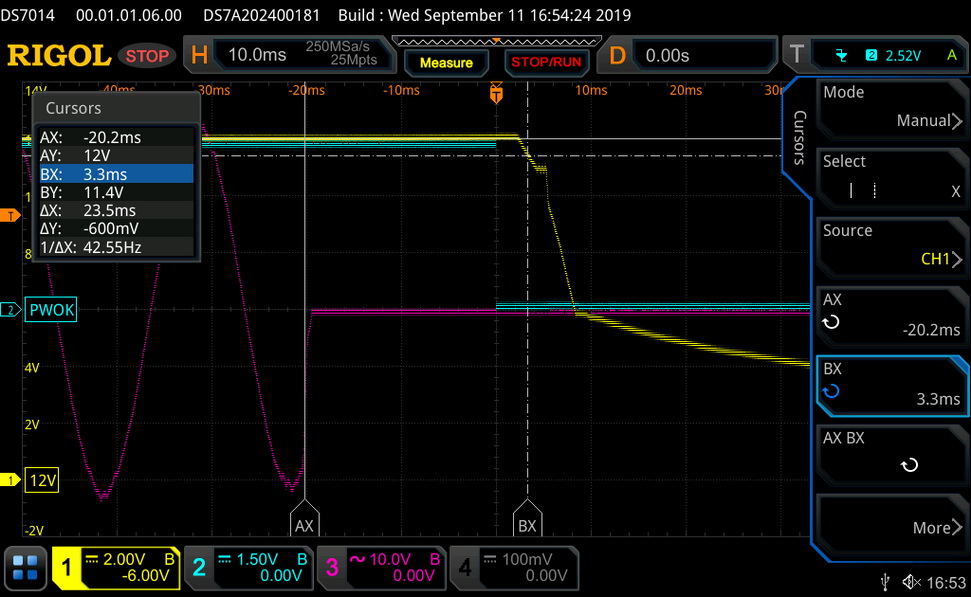
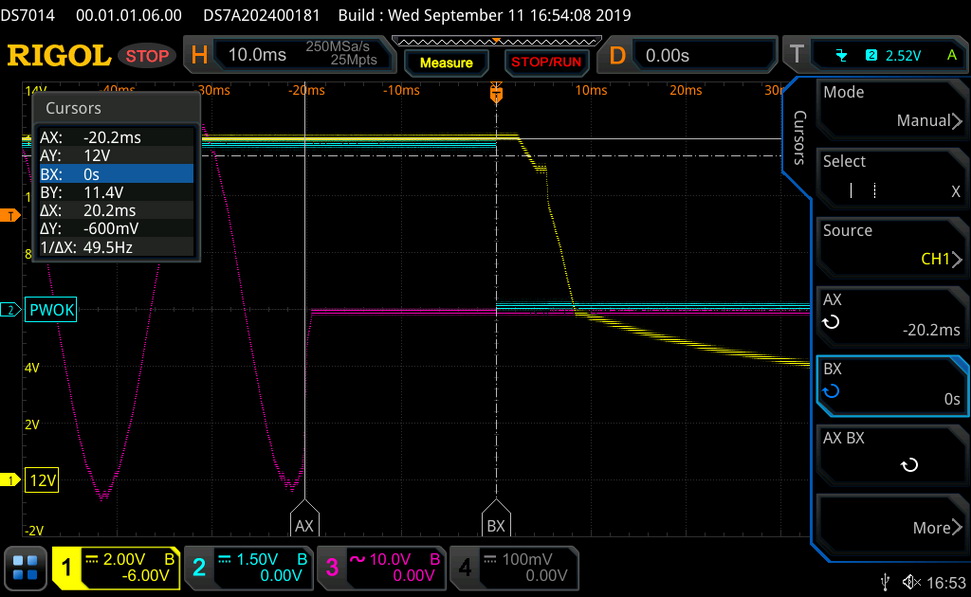
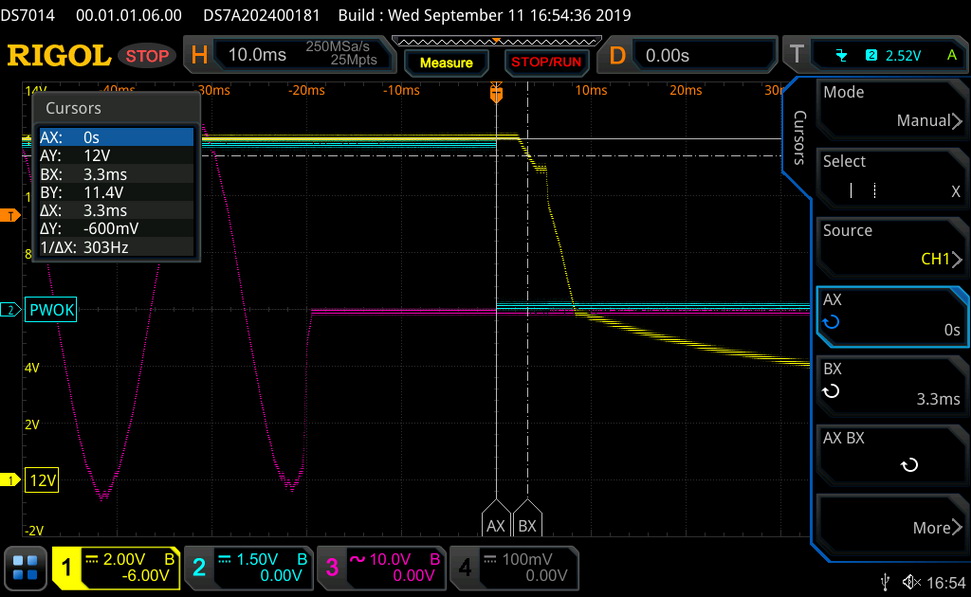
The hold-up time is long and the power ok signal is accurate.
Inrush Current
Inrush current, or switch-on surge, refers to the maximum, instantaneous input current drawn by an electrical device when it is first turned on. A large enough inrush current can cause circuit breakers and fuses to trip. It can also damage switches, relays, and bridge rectifiers. As a result, the lower the inrush current of a PSU right as it is turned on, the better.
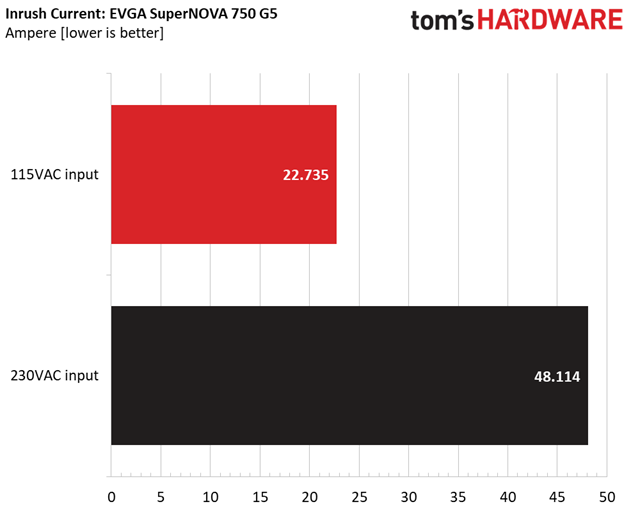
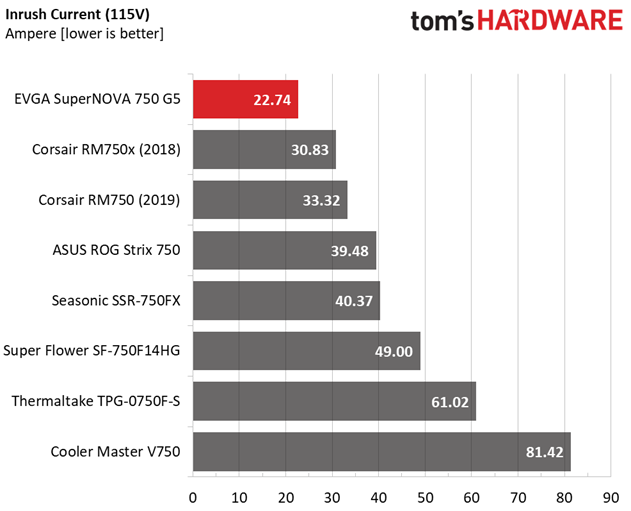
The inrush current is low with both voltage inputs.
Get Tom's Hardware's best news and in-depth reviews, straight to your inbox.
10-110% Load Tests
These tests reveal the G5’s load regulation and efficiency levels under high ambient temperatures. They also show how the fan speed profile behaves under increased operating temperatures.
| Test # | 12V | 5V | 3.3V | 5VSB | DC/AC (Watts) | Efficiency | Fan Speed (RPM) | PSU Noise (dB[A]) | Temps (In/Out) | PF/AC Volts |
|---|---|---|---|---|---|---|---|---|---|---|
| 1 | 4.384A | 2.026A | 1.993A | 1.018A | 74.581 | 84.032% | 0 | <6.0 | 45.19°C | 0.966 |
| 12.085V | 4.936V | 3.311V | 4.913V | 88.753 | 40.29°C | 115.15V | ||||
| 2 | 9.812A | 3.042A | 2.990A | 1.223A | 149.434 | 88.737% | 0 | <6.0 | 46.38°C | 0.988 |
| 12.080V | 4.934V | 3.309V | 4.908V | 168.401 | 41.08°C | 115.15V | ||||
| 3 | 15.648A | 3.548A | 3.477A | 1.429A | 224.971 | 90.185% | 0 | <6.0 | 47.09°C | 0.993 |
| 12.076V | 4.933V | 3.307V | 4.902V | 249.455 | 41.49°C | 115.15V | ||||
| 4 | 21.418A | 4.060A | 3.993A | 1.636A | 299.743 | 90.356% | 1379 | 37.5 | 41.78°C | 0.997 |
| 12.071V | 4.927V | 3.306V | 4.892V | 331.737 | 48.33°C | 115.16V | ||||
| 5 | 26.864A | 5.080A | 4.994A | 1.843A | 374.686 | 90.407% | 1481 | 40.2 | 42.03°C | 0.999 |
| 12.067V | 4.924V | 3.304V | 4.886V | 414.442 | 49.27°C | 115.16V | ||||
| 6 | 32.315A | 6.097A | 5.997A | 2.049A | 449.630 | 90.102% | 1670 | 42.6 | 42.88°C | 0.999 |
| 12.063V | 4.922V | 3.302V | 4.881V | 499.025 | 50.75°C | 115.16V | ||||
| 7 | 37.800A | 7.117A | 7.001A | 2.257A | 524.955 | 89.649% | 1773 | 46.1 | 43.23°C | 0.999 |
| 12.059V | 4.920V | 3.300V | 4.876V | 585.570 | 51.67°C | 115.16V | ||||
| 8 | 43.294A | 8.137A | 8.008A | 2.465A | 600.283 | 89.053% | 1882 | 46.2 | 43.80°C | 0.999 |
| 12.054V | 4.917V | 3.297V | 4.870V | 674.074 | 52.45°C | 115.16V | ||||
| 9 | 49.150A | 8.648A | 8.496A | 2.464A | 674.816 | 88.359% | 1930 | 47.9 | 44.66°C | 0.999 |
| 12.051V | 4.915V | 3.296V | 4.871V | 763.723 | 53.67°C | 115.17V | ||||
| 10 | 54.808A | 9.159A | 9.017A | 3.095A | 750.044 | 87.460% | 1935 | 48.8 | 45.89°C | 0.999 |
| 12.048V | 4.914V | 3.294V | 4.849V | 857.587 | 55.14°C | 115.18V | ||||
| 11 | 61.074A | 9.161A | 9.020A | 3.095A | 825.282 | 86.681% | 1937 | 48.9 | 46.67°C | 0.999 |
| 12.044V | 4.913V | 3.292V | 4.848V | 952.094 | 56.52°C | 115.17V | ||||
| CL1 | 0.155A | 14.001A | 14.001A | 0.000A | 117.073 | 80.557% | 0 | <6.0 | 49.25°C | 0.984 |
| 12.082V | 4.933V | 3.295V | 5.004V | 145.329 | 41.76°C | 115.17V | ||||
| CL2 | 62.528A | 1.004A | 1.001A | 1.000A | 766.544 | 87.976% | 1935 | 48.8 | 45.96°C | 0.999 |
| 12.049V | 4.923V | 3.299V | 4.899V | 871.306 | 55.53°C | 115.17V |
What makes an impression here is that during the CL1 test, the fan stops to spin, because of the low load, although the operating temperature is close to 42 degrees Celsius. Normally, the fan should spin at low RPM, to cool down the PSU's internals.
The 750 G5 easily meets the corresponding 80 PLUS Gold requirements, even at high ambient temperatures.
20-80W Load Tests
In the following tests, we measure the G5's efficiency at loads significantly lower than 10% of its maximum capacity (the lowest load the 80 PLUS standard measures). This is important for representing when a PC is idle with power-saving features turned on.
| Test # | 12V | 5V | 3.3V | 5VSB | DC/AC (Watts) | Efficiency | Fan Speed (RPM) | PSU Noise (dB[A]) | PF/AC Volts |
|---|---|---|---|---|---|---|---|---|---|
| 1 | 1.203A | 0.508A | 0.480A | 0.203A | 19.641 | 67.551% | 0 | <6.0 | 0.881 |
| 12.088V | 4.937V | 3.313V | 4.934V | 29.076 | 115.16V | ||||
| 2 | 2.463A | 1.012A | 0.996A | 0.406A | 40.065 | 78.287% | 0 | <6.0 | 0.935 |
| 12.087V | 4.936V | 3.312V | 4.929V | 51.177 | 115.16V | ||||
| 3 | 3.651A | 1.520A | 1.479A | 0.609A | 59.520 | 82.740% | 0 | <6.0 | 0.955 |
| 12.085V | 4.935V | 3.311V | 4.925V | 71.936 | 115.15V | ||||
| 4 | 4.908A | 2.027A | 1.992A | 0.813A | 79.911 | 84.868% | 0 | <6.0 | 0.969 |
| 12.085V | 4.935V | 3.311V | 4.920V | 94.159 | 115.15V |
The efficiency with light loads is low.
2% or 10W Load Test
Intel plans on raising the ante at efficiency levels under ultra-light loads. So from July 2020, the ATX spec will require 70% and higher efficiency with 115V input. The applied load is only 10W for PSUs with 500W and lower capacities, while for stronger units we dial 2% of their max-rated-capacity.
| Test # | 12V | 5V | 3.3V | 5VSB | DC/AC (Watts) | Efficiency | Fan Speed (RPM) | PSU Noise (dB[A]) | PF/AC Volts |
|---|---|---|---|---|---|---|---|---|---|
| 1 | 1.069A | 0.245A | 0.243A | 0.051A | 15.187 | 62.635% | 0 | <6.0 | 0.687 |
| 12.087V | 4.932V | 3.313V | 4.933V | 24.247 | 115.16V |
EVGA states that this unit is compatible with the ATX v2.52 specification, however from July 2020 the same spec will ask for at least 70% efficiency under such light load levels.
Efficiency
Next, we plotted a chart showing the G5’s efficiency at low loads, and loads from 10 to 110% of its maximum-rated capacity. The higher a PSU’s efficiency, the less energy goes wasted, leading to a reduced carbon footprint and lower electricity bills.
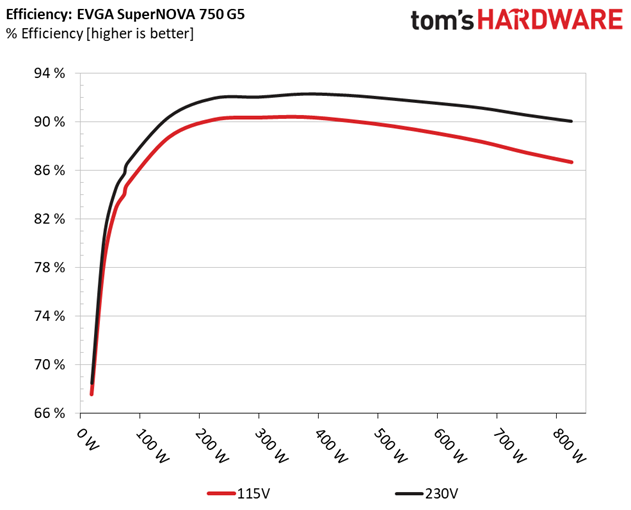
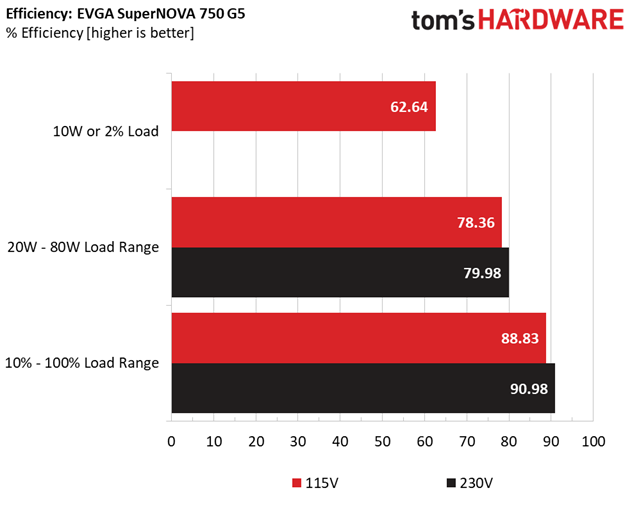
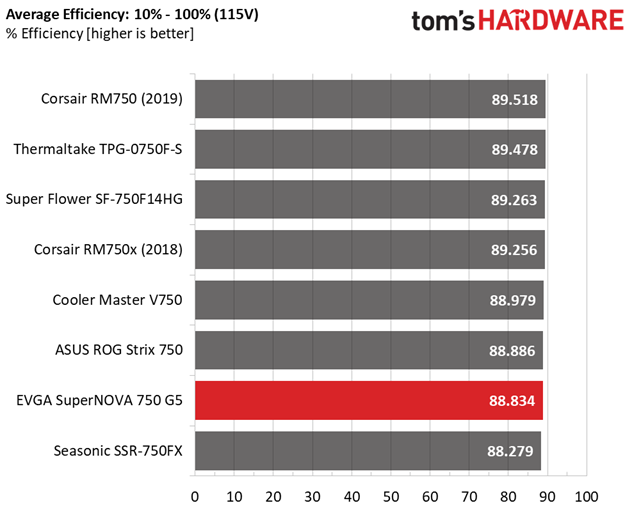
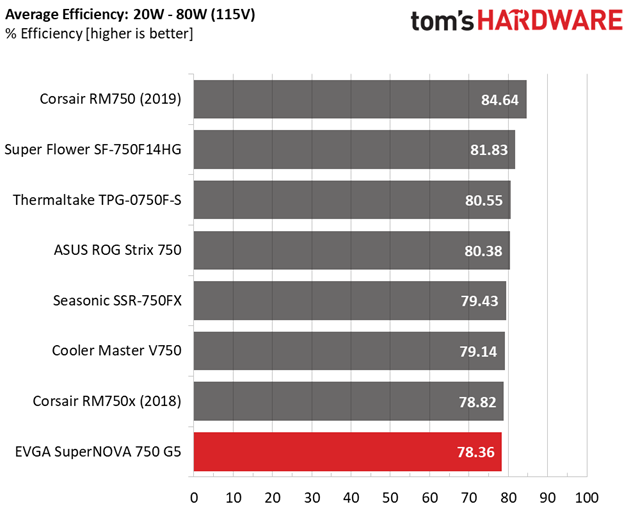
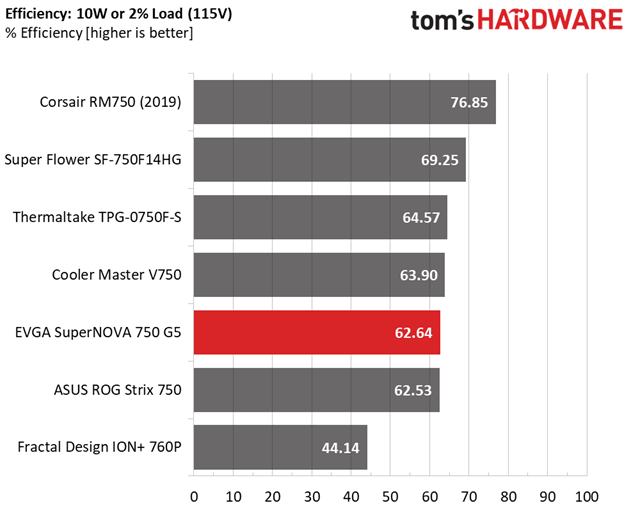
With normal loads the unit's efficiency is satisfactory, but this is not the case with light and super-light loads.
5VSB Efficiency
| Test # | 5VSB | DC/AC (Watts) | Efficiency | PF/AC Volts |
|---|---|---|---|---|
| 1 | 0.100A | 0.512 | 67.546% | 0.074 |
| 5.123V | 0.758 | 115.14V | ||
| 2 | 0.250A | 1.279 | 76.040% | 0.153 |
| 5.118V | 1.682 | 115.14V | ||
| 3 | 0.550A | 2.809 | 78.093% | 0.273 |
| 5.107V | 3.597 | 115.13V | ||
| 4 | 1.000A | 5.093 | 77.260% | 0.376 |
| 5.092V | 6.592 | 115.13V | ||
| 5 | 1.500A | 7.615 | 78.887% | 0.429 |
| 5.076V | 9.653 | 115.14V | ||
| 6 | 3.000A | 15.077 | 76.580% | 0.503 |
| 5.026V | 19.688 | 115.13V |
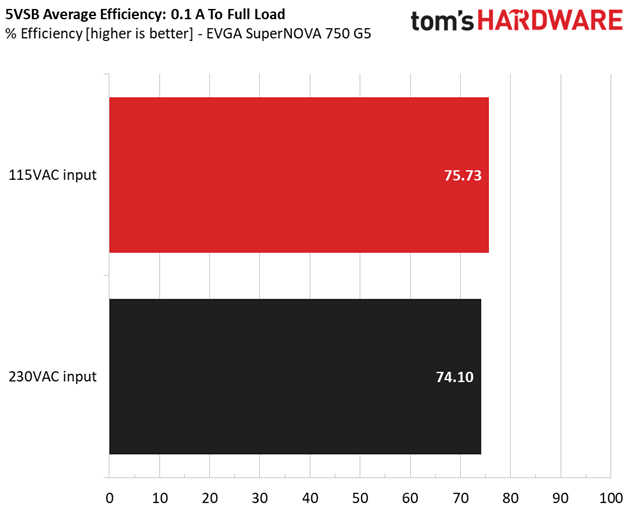
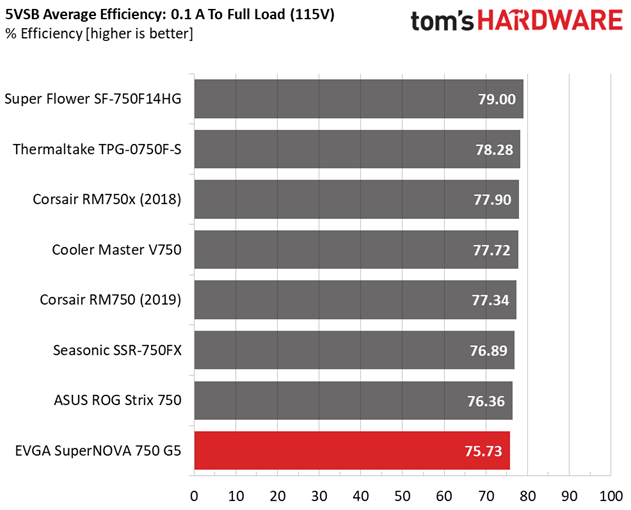
The 5VSB is has low efficiency, especially with 230V input.
Power Consumption In Idle And Standby
| Mode | 12V | 5V | 3.3V | 5VSB | Watts | PF/AC Volts |
|---|---|---|---|---|---|---|
| Idle | 12.087V | 4.928V | 3.313V | 4.929V | 8.148 | 0.458 |
| 115.2V | ||||||
| Standby | 0.172 | 0.017 | ||||
| 115.2V |
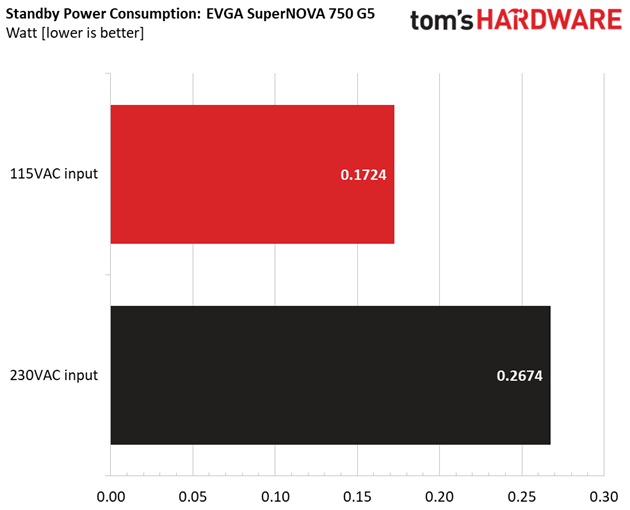
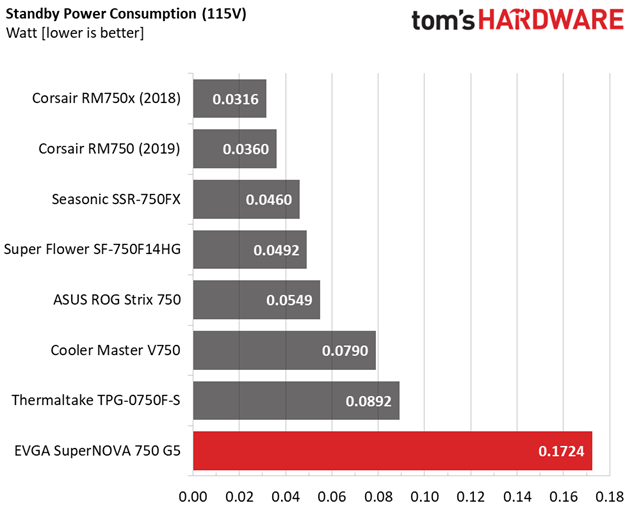
The vampire power exceeds 0.25W and this is why the 750 G5 cannot meet the requirements even of the lowest Cybenetics efficiency rating. It is a shame to see such high energy consumption at standby, in a modern PSU.
Fan RPM, Delta Temperature, And Output Noise
All results are obtained between an ambient temperature of 37 to 47 degrees Celsius (98.6 to 116.6 degrees Fahrenheit).
The fan profile is super aggressive when the power supply is pushed hard, under high temperatures.
The following results were obtained at 30 to 32 degrees Celsius (86 to 89.6 degrees Fahrenheit) ambient temperature.
The passive operation lasts for quite long, but afterward, the fan quickly increases its speed, and with higher than 525W loads, the noise output exceeds 40 dB(A).
MORE: Best Power Supplies
MORE: How We Test Power Supplies
MORE: All Power Supply Content
Current page: Load Regulation, Hold-Up Time, Inrush Current, Efficiency and Noise
Prev Page Specifications and Part Analysis Next Page Protection Features, DC Power Sequencing, Cross-Load Tests and Infrared Images
Aris Mpitziopoulos is a contributing editor at Tom's Hardware, covering PSUs.
-
Yuniel Hello Aris , you still recommened the g3 ? , beacuse aparently is in tier Tier D - Not recommended https://linustechtips.com/main/topic/1116640-psu-tier-list-40-rev-103/ , beacuse of OPP , the 850 g3 is good PSU for high end PC gaming ?Reply -
mossberg ReplyYuniel said:Hello Aris , you still recommened the g3 ? , beacuse aparently is in tier Tier D - Not recommended https://linustechtips.com/main/topic/1116640-psu-tier-list-40-rev-103/ , beacuse of OPP , the 850 g3 is good PSU for high end PC gaming ?
That list is a joke. -
agentlaidlaw Reply
linus forums are spreading fear mongering. they use toms own reviews about the G3 series as their reasoning while simultaneously ignoring toms still recommendation for it IN THOSE SAME REVIEWS. they all of a sudden don't care about the authors opinion. they pick and choose what they want to hear and spread misinformation and instill paranoia and fear mongering into people. and also flat-out ignore jonnyguru reviews for it as well. while simultaneously using jonny's reviews for recommending other power supplies.Yuniel said:Hello Aris , you still recommened the g3 ? , beacuse aparently is in tier Tier D - Not recommended https://linustechtips.com/main/topic/1116640-psu-tier-list-40-rev-103/ , beacuse of OPP , the 850 g3 is good PSU for high end PC gaming ?
do yourself a favor and ignore that dumb list. the guy who took control of it is going on a fear mongering spree and has admitted hes basing everything off his own opinion rather than facts. he doesn't like single rails and telling people single rails will blow up on them if you use them in units past 600 watts or so. he's not correcting users going around on that forum stating single rails don't support ocp / opp. he's spreading misinformation about a plethora of power supplies, hes ranking power supplies that are objectively worse over nitpicking stuff. like the g3 opp that's only a concern if you ARE ALREADY PUSHING THE POWER SUPPLY BEYOND ITS RATED SPEC NO MATTER WHAT EVEN WITH GOOD OPP YOU WILL STILL HAVE PROBLEMS IN THOSE SCENARIOS OVER TIME OF CONSTANT PUSHING OVER SPEC.
sorry for my rant but linus power supply tier has been the worse thing to come about in the community. -
WigitMigit Could I download evga's software and adjust the fan curve to deal with the loud fan issue? Or does their software not work with the g5 lineupReply -
TJ Hooker Reply
What software are you referring to? I've never heard of software that lets you change your PSU fan profile, except for Corsair link (which only works with a few of their high end PSUs).WigitMigit said:Could I download evga's software and adjust the fan curve to deal with the loud fan issue? Or does their software not work with the g5 lineup -
WigitMigit Reply
https://www.evga.com/supernova/TJ Hooker said:What software are you referring to? I've never heard of software that lets you change your PSU fan profile, except for Corsair link (which only works with a few of their high end PSUs). -
TJ Hooker Reply
Interesting, didn't realize EVGA had something similar. But it looks like it works only with that one PSU model from ~7 years ago, guess it's not too surprising I hadn't heard of it.WigitMigit said:https://www.evga.com/supernova/ -
VTEC_Inside There is an issue with this review IMO.Reply
Active Clamp Reset Forward designs characteristically hold steady voltages better.
The criticism regarding transient response is flawed in that it is not tested the way that people are actually going to use the things, ie with the caps in place.
While I'm sure no one is stamping an official seal of approval on PSUs, I'd imagine they'd be ripped on pretty hard if it didn't actually adhere to ATX specifications.
Evga's marketing wank goes on about the higher quality capacitors on the output board. A more useful test, IMO, would be to test that transient response under conditions that people are actually using the thing. Given that it only slightly failed this testing methodology without the caps, I'm left to believe that it would do just fine tested in a real world situation.
